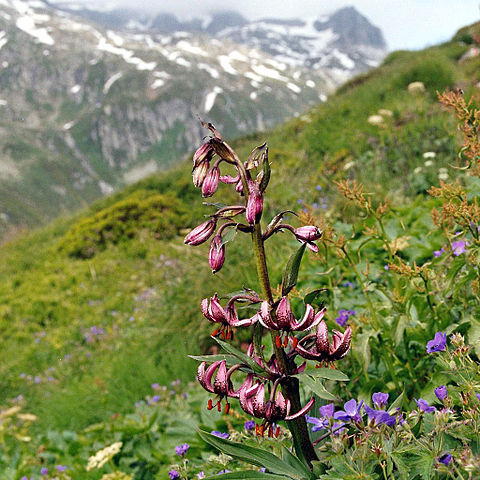Perennial herbs with annual or evergreen aerial shoots arising from bulbs, corms, tubers or rhizomes, or evergeen shrubs or climbers. Roots fibrous or tuberous. Leaves alternate in 2 or 3 ranks or (not in Australia) opposite, often basal, terete, linear, lanceolate or ovate, sometimes with pseudopetiole, sometimes resupinate or reduced to scales, sometimes withered by flowering, the branches then phyllocladous; base usually sheathing; venation convergent or (not in Australia) reticulate. Flowers unisexual or bisexual, actinomorphic or zygomorphic, in terminal or axillary spikes, racemes, corymbs, umbels or panicles, rarely solitary and terminal or axillary. Sepals 3, petals 3, or fewer or more, free or fused, similar or dissimilar; when fused a corona sometimes present. Stamens 3 or 6, rarely 4 or 10-14, or (not in Australia) 8 or 12; where less than 6, staminodes may be present; anthers bilocular, dehiscing by slits or apical pores, introrse, extrorse or latrorse. Ovary superior, inferior or semi-inferior; locules 1, 3 or rarely 4-7; styles 1 or 3; stigma capitate, 2-or 3-lobed, trifid or very small, or stigmas 3-7; ovules 1 to many per locule; placentas basal, axile or parietal. Fruit a berry, capsule or dry and indehiscent. Seeds smooth, or variously ornamented or winged, rarely papillose or hairy; elaiosome present or absent; endosperm lacking starch.
Herbs perennial, with a rhizome, bulb, or corm, rarely shrubby or treelike. Leaves basal and/or cauline, alternate, opposite, or whorled, parallel or rarely reticulate veined. Inflorescence a raceme, panicle, spike, umbel, reduced panicle, or other, or flowers solitary. Flowers bisexual, rarely unisexual, actinomorphic, rarely zygomorphic; bracts present or absent; bracteoles present or absent. Perianth usually corollalike, 6-merous, rarely 4-or 8-merous, in 2 whorls; segments free (tepals) or united. Stamens 6, rarely 3, 4, or 8, inserted opposite perianth segments; filaments free or adnate to perianth, rarely connate into a corona; anthers usually 2-loculed, basifixed or dorsifixed and versatile, introrse, latrorse, or extrorse, dehiscing usually by vertical slits. Carpels usually connate for most or all of their length, rarely only at base; ovary superior, rarely semi-inferior, 3-loculed, rarely 2-or 4-loculed, with axile placentae, or rarely 1-loculed with a parietal placenta; ovules usually anatropous. Nectaries septal, perigonal, or absent. Fruit a capsule or berry. Seeds with abundant endosperm and small embryo.
Erect perennial geophytes; bulbs formed of 1 to many scales attached to reduced stem, tunicate or not. Leaves basal or cauline, sometimes petiolate, 1-many, alternate or verticillate, linear to ovate-lanceolate, bases sometimes sheathing, veins parallel. Inflorescence a terminal raceme, sometimes umbel-like, or a single terminal flower, bracts subtending flowers absent or present and leaf-like. Flowers hermaphrodite, actinomorphic or occasionally weakly zygomorphic. Perianth segments 6 in 2 whorls, free to base, usually brightly coloured, often with contrasting basal nectaries. Stamens in 2 series of 3; anthers dehiscing by longitudinal slits. Ovary superior, trilocular, with numerous ovules per locule; style solitary, erect, short to long; stigma capitate to 3-lobed. Fruit a loculicidal capsule with numerous seeds. Seeds flattened, discoid to ellipsoidal
Stamens usually 6, hypogynous or adnate to and always opposite to the perianth segments; filaments usually free; anthers 2-celled, usually opening by a slit lengthwise
Herbs, mostly perennial, or rarely soft-wooded shrubs; roots from a rhizome, corm or bulb, or tuberous; stem erect or climbing, leafy or scapose
Ovary superior, mostly 3-locular with axile placentas, or rarely 1-locular with parietal placentas; style entire or divided, rarely styles free
Perianth mostly corolla-like, with or without a tube; segments usually 6, rarely 4 or more, in 2 similar series, imbricate or the outer valvate
Flowers bisexual or rarely unisexual, actinomorphic or slightly zygomorphic, sometimes large and showy, never in umbels
Ovules usually numerous and mostly 2-seriate in each loculus
Seeds with copious endosperm
Fruit a capsule or berry

